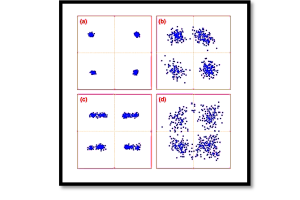
Phase Shift Keying (PSK) and Binary Phase Shift Keying (BPSK)
Digital communication systems have transformed the way we exchange data, enabling high-speed, reliable, and efficient transmission over vast distances. One cornerstone of modern digital communication is Phase Shift Keying (PSK), a technique that leverages the phase of a carrier wave to encode digital information. In this blog, we will delve into the principles of PSK and its most fundamental variant, Binary Phase Shift Keying (BPSK), exploring their technical underpinnings, advantages, and applications.
Understanding Phase Shift Keying (PSK)
Phase Shift Keying (PSK) is a modulation technique used in digital communication, where the phase of a reference carrier signal is altered to represent digital data. Unlike amplitude modulation (AM) or frequency modulation (FM), PSK is highly resistant to noise and interference because the phase is less susceptible to distortion in noisy environments.
Key Concept:
The carrier signal in PSK can be mathematically represented as:

In PSK, digital data (typically binary) is encoded by shifting the phase of the carrier wave. Each distinct phase corresponds to a particular symbol or bit sequence. For instance:
- Binary 0 may be represented as a phase of 180∘ (or π).
- Binary 1 may correspond to a phase of 0∘.
This simple phase-shifting mechanism forms the foundation for more advanced forms of PSK.

Introducing Binary Phase Shift Keying (BPSK)
Binary Phase Shift Keying (BPSK) is the simplest form of PSK. As the name suggests, BPSK utilizes two distinct phases—separated by 180∘—to represent binary data. Its simplicity and robustness make it one of the most widely used modulation schemes in digital communication systems.
Binary Representation:
- Binary 0 corresponds to a phase of 180∘ (π radians).
- Binary 1 corresponds to a phase of 0∘.
Mathematical Representation:

Waveform Characteristics:
- The amplitude of the carrier wave remains constant.
- Phase changes encode the data.
- A 180° phase shift occurs when transitioning between binary 0 and binary 1.

Advantages of PSK and BPSK
- Robustness in Noisy Environments:
Since PSK relies on the phase, which is less prone to distortion compared to amplitude, it is highly reliable in environments with noise and interference. - Bandwidth Efficiency:
BPSK is spectrally efficient, making it suitable for systems with limited bandwidth. - Simple Implementation:
BPSK’s use of only two phase states simplifies both modulation and demodulation hardware, reducing costs. - Error Performance:
BPSK has better noise immunity compared to schemes like Amplitude Shift Keying (ASK), though it requires more bandwidth for the same data rate.
Applications of PSK and BPSK
- Wireless Communication:
BPSK is extensively used in wireless LANs, RFID systems, and Bluetooth communication due to its simplicity and robustness. - Satellite Communication:
The noise resilience of PSK makes it ideal for satellite links where signal distortion is a challenge. - NFC and RFID Systems:
Contactless operations, such as biometric authentication and NFC payments, rely on PSK for secure and reliable data transfer. - Global Positioning Systems (GPS):
The GPS signal structure incorporates variants of PSK for precise positioning.
Beyond BPSK: Higher-Order PSK
While BPSK is simple and effective, its data rate is limited to one bit per symbol. For higher data rates, advanced forms of PSK introduce additional phase states. Examples include:
Quadrature Phase Shift Keying (QPSK):
- QPSK uses four distinct phases (e.g., 0∘,90∘,180∘,270∘) to encode two bits per symbol.
- This doubles the data rate compared to BPSK without requiring additional bandwidth.
8-PSK and Beyond:
- By increasing the number of phase states (e.g., 8, 16, or 32 phases), more bits can be encoded per symbol.
- However, these higher-order schemes are more susceptible to noise due to reduced phase separation.
Trade-offs:
- While higher-order PSK offers improved data rates, it demands higher SNR (Signal-to-Noise Ratio) for reliable communication.
Take our entry level course (Below) for free using coupon code RAHRF101BLOG
RF Fundamentals, Basic Concepts and Components – RAHRF101
For limited time take an additional 10% off of all our courses using coupon code RFCERT10
Rahsoft RF Certificate and courses
Conclusion
Phase Shift Keying, and specifically Binary Phase Shift Keying, stands as a cornerstone of modern digital communication. Its simple yet effective method of encoding data in the phase of a carrier wave provides excellent noise immunity, bandwidth efficiency, and implementation simplicity. From wireless networks to contactless operations, PSK remains indispensable in diverse communication technologies. As data demands grow, the foundational concepts of BPSK are extended to higher-order PSK schemes, balancing data rate and reliability. Understanding these principles is not only crucial for communication engineers but also essential for developing future technologies in a rapidly evolving digital landscape.

Learn more about this topic by taking the complete course ‘Introduction to Modulation in Communication Systems Online Course – RAHRF152’. Watch the course videos for more detailed understanding. Also checkout other courses on RF system and IC design on https://rahsoft.com/courses/. Rahsoft also provides a certificate on Radio Frequency. All the courses offer step by step approach.



